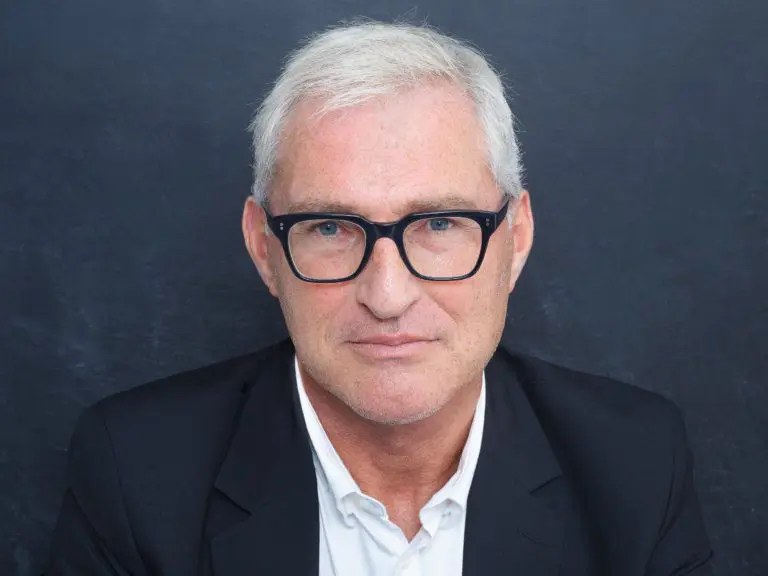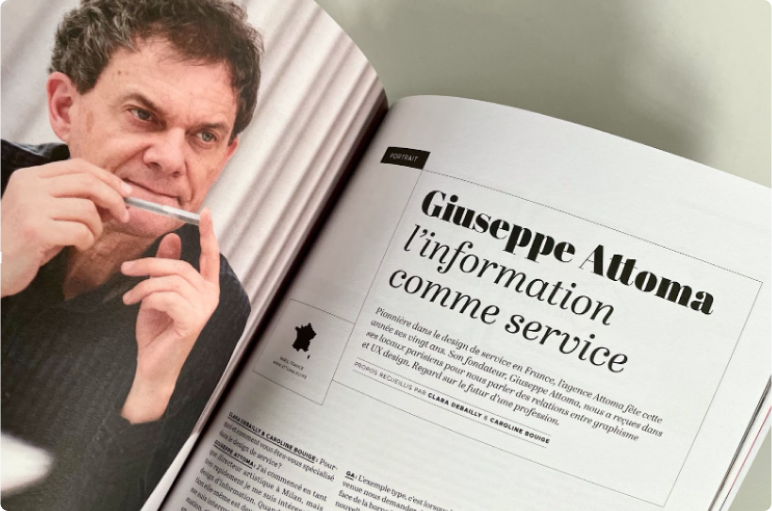Here we publish Christophe Chaptal’s interview with Giuseppe Attoma Pepe, published in issue 1242 of the Design Fax newsletter of June 17, 2022 and subsequently on the Admirable Design website. It’s also an opportunity to pay a heartfelt tribute to Jean-Charles Gaté, founder in 1995 of France’s only design newsletter, and to Christophe Chaptal, who took over as editor when he passed away in 2018.
Giuseppe Attoma Pepe, could you tell us about your background?
G.A.P. My background is a bit atypical. I’m Italian and began my career in comics, graphic design and art direction, all self-taught. I’ve been lucky enough to meet some great masters and to be given some great support: in Switzerland and in Milan, where in the 1990s I was able to work with the likes of Ettore Sottsass and other designers of this calibre. The chance to work alongside designers of great stature was a very formative period. At the same time, I’ve always followed a guiding principle in my head, not yet well defined as a practice, which is information design, i.e. how complex content should be organized to make it immediately accessible and usable. This quickly led to my involvement in the financial sector, where I needed to make complex data easy to understand, but also, soon afterwards, in the field of mobility. In 1997, I set up my own agency in France and worked with Yo Kaminagai (editor’s note: former Design Delegate in the Project Management Department at RATP) for a very busy season of passenger information point projects, including, in 2001-2002, the first touch-screen kiosk for the general public, the Navigo card recharging kiosk. At the time, few methodological practices were available, and we won the consultation because we were already focusing on the user experience with a UX-type approach. Incidentally, the Navigo top-up interface is still in use 20 years later, to the satisfaction of users, which is a source of pride for me. These dimensions of interaction and experience have come together in a specific offering that has positioned Attoma in sectors where complexity reigns: mobility, transport operators, but also the industrial sector where man-machine interaction and the user journey are particularly structuring. All this has enriched our experience and expertise over the years.
For me, the future of design may not be design itself.
Tell us about your agency and your business?
G.A.P. Our subject is the user, faced with the complex world with which he must interact. This positioning, very positively appreciated in the French landscape, has enabled us to welcome and train a large number of designers, which I’m very happy about. In 2019, given the underlying trend towards concentration in the design field, we decided to join the Italian group Assist Digital, which boasts an original positioning and a 130-strong design unit, with a design approach very similar to ours and a particularly advanced customer experience culture. Assist Digital owns all Attoma shares and I own shares in the group. Assist Digital has sales of €140 million (2021), with significant growth targets. Thanks to our membership of this group, we now have a presence in Europe. We managed to get through the Covid-19 episode, and in 2021 growth resumed, with the ambition of expanding Attoma’s offering, now called Assist Digital France, to go beyond the traditional focus on design and make it part of a more complex issue – consulting, user experience and design – that we can now take to an international level. It’s a theme that’s really in the air: pure player design is a thing of the past. Design has penetrated the different strata of the company, and must therefore be able to dialogue at all levels, hierarchical or functional. We’re obviously asking a lot of questions about the evolution of design. For me, the future of design may not be design itself. That’s yet to be invented. For example, what is augmented design? It’s not quite clear yet. What’s certain is that there’s a card to play between the consulting dimension and the design dimension. Not all players are mature, it’s still in its infancy, but it’s certainly one of the big issues in our business. The strategic and organizational dimension of design is crucial. At Assist Digital, we have major customers such as Stellantis and Toyota Europe: it’s clear that major groups are thinking in terms of augmented design. Another area we particularly appreciate is that of energy transformation. We work for Plenitude (editor’s note: the new name of Eni Gas & Luce). We also do a lot of work for Schneider Electric to find out how to innovate and create in rapidly changing energy and environmental contexts.
Pure player design is a thing of the past
How do you see your business evolving over the next five to 10 years?
G.A.P. Interesting debate! One subject among many: Attoma is in a very digital, very UX dimension, and it’s clear that overall this is a booming market. It’s very difficult to recruit, and salary levels are high. But if we analyze it in more detail, we need to distinguish between design that is more concerned with the strategic approach (customer journey, ecosystem, innovation support) and design that is more concerned with industrial aspects, such as design ops (editor’s note: design operations), where the aim is to manage massive digital projects that consume a lot of resources. Please don’t see any value judgments in what I’m about to say, but many UX designers are a bit like skilled workers in this digitalizing industry. Tomorrow we may have to manage a kind of “digital design steel crisis”, as automation advances. Players such as Figma eliminate the need for manpower by automating processes. The question is: what will become of these cohorts of UX designers? Today, we’re somewhere between mass production and luxury craftsmanship. What role will design automation play in the future? Generally speaking, you need to be able to manage both the strategic and operational components of design. Our strategy is to work with companies and institutions on meaning, quality of life and experience, using a unique design methodology. For the moment, not everything has been fully defined, but things are moving forward at different levels of maturity in different industries. Among players in the mobility and energy transition sectors, the changes are also noteworthy. For example, we have set up an approach for certain Schneider Electric activities that combines the two dimensions of design: strategic approach and design ops.
Tomorrow we may have to manage a kind of “digital design steel crisis”, as automation advances.
Your vision of French design?
G.A.P. I don’t know what French design is. I’ve never been much for this French touch rhetoric. I’m an Italian who’s been living in France for 25 years. I’ve always traveled a lot. Above all, I feel European, immersed in a European culture, and finally this question of local design is fading. I’m not very interested in French design issues, especially as French object and furniture design has tended to be promoted by Italian publishers! The richness of design lies above all in this blend of cultures and know-how. Design is by definition international.
A final message?
G.A.P. It may be an anti-commercial stance, but you have to learn to doubt. We see a lot of people with very strong certainties and beliefs, particularly from a methodological point of view. I have my doubts. Our times are extraordinarily complex, and we need to remain humble because so much remains to be invented. There’s no need to beat about the bush: is the world better and easier than it was 10 years ago: the answer isn’t necessarily yes. There are a lot of failures we haven’t really taken into account, so learning to doubt is important. Lacking humility, we don’t always ask ourselves the right questions, and we don’t go as far as we could. I’d love to create a Master’s degree in Doubt Design!



